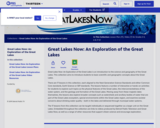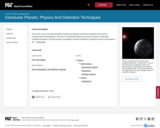
This video from Evolution highlights Charles Darwin's personal struggle to bring to light his theory of evolution through natural selection. [6:31]
- Subject:
- Science
- Material Type:
- Audio/Video
- Provider:
- PBS LearningMedia
- Date Added:
- 11/06/2023


This video from Evolution highlights Charles Darwin's personal struggle to bring to light his theory of evolution through natural selection. [6:31]

In this video, discover why evolution is important to our understanding of disease prevention and treatment in Russia and around the world.

A narrated tutorial which illustrates how the work-energy theorem can be expanded to include other kinds of energy. [10:07]

Interactive site provides information on the Breakup of Pangea, plate boundaries, plate movements as well as a quiz.

In this video segment adapted from ZOOM, the cast investigates how the pitch of sound changes when they strike a variety of glasses filled with different amounts and types of liquids. [5:07]

Great Lakes Now: An Exploration of the Great Lakes is an introduction to the science and study of the Great Lakes. This collection aims to introduce students to basic scientific and geographic concepts about the Great Lakes. There are 17 lessons in this collection, each aligned to the Next Generation Science Standards and either Common Core standards, Earth Science or SEP standards. The lessons feature a number of interactive or hands-on activities for students to explore such topics as the physical features of the Great Lakes, the interconnectedness of the water system, and the geology and formation of the Great Lakes. Moving away from these majestic lakes themselves, the lessons also explore broader concepts such as watersheds and ancillary bodies of water that are part of the Great Lakes ecosystem, special environments within the Great Lakes region, and examine societal concerns about drinking water quality – both in the lakes and delivered through municipal water systems. The 17 lessons from this collection can be taught individually or sequenced together as a larger unit on the Great Lakes. Embedded throughout the collection are links to videos produced by Detroit Public Television and Great Lakes Now, as well as a range of other resources that support citizen science and encourage exploration.

This outstanding website provides an excellent variety of hands-on earthquake activities to help you understand what causes earthquakes.

This lesson will focus on bony fish form and adaptations. Students will begin by looking at different types of marine life, particularly fish, in the Aurelia application. After discussing the 3 different classes of fish and basic fish anatomy, students will take a deeper dive into the bony fish class and learn about the adaptations that they have to survive in different ecosystems. At the end of the lesson, students will be able to identify the external anatomy of a bony fish and be able to tell the difference between a bony, cartilaginous or jawless fish.
Estimated time required: 1-2 class periods.
Technology required for this lesson: Tablet or Smartphone.

This lesson will focus on cartilaginous fish form and adaptations. Students will begin by looking at different types of marine life, particularly fish, in the Aurelia application. After discussing the biological classification system and the 3 classes of fish, students will learn the external anatomy of the main groups of cartilaginous fish. Students will then take a deeper dive into the adaptations of cartilaginous fish that make them different from bony fish. We will finish up by covering modern issues that are facing cartilaginous fish and how we can help their populations.
Estimated time required: 1-2 class periods.
Technology required for this lesson: Tablet or Smartphone.

In this video segment adapted from ZOOM, cast members join hands and become electron conductors to complete an electric circuit. [3:32]

This tutorial looks at carbon dioxide in the atmosphere and how changes can impact wheat production in Kansas.

This section of the exhibition gives the history of the discovery and study of space starting with the Greeks and Romans through to the early 1900's.

Part of the National Air and Space Museum's online exhibition about Exploring Planets, this describes and gives visuals of telescopes, probes and fly-by aircrafts, orbiters, and landers as current methods for earth and airborne exploration of the planets. The tools and technology used to get, bring back, and analyze samples are also included.

In this activity, participants explore the complex but predictable ways objects in the universe interact with each other. Stars, planets, moons, and other objects in space orbit around each other because of gravity, and NASA scientists can use what we already know about the laws of physics to make new discoveries and predictions. Participants in this activity use orbiting clay balls to make simple, functioning models of interacting objects in space. Both English and Spanish activity resources are included. Educators should begin with the file named: Objects in Motion - Lesson Plan - START HERE.
Estimated time required: 1-2 class periods.
Technology required for this lesson: Tablet or Smartphone.

Video writing prompt where students are asked to explain how lava is involved in the rock cycle. [0:32]

Discusses many options of water treatment, the contaminants that the treatments are focused on, how the treatment works, and common treatment systems.

A university-level course that examines the atmospheres and interiors of extrasolar planets, or exoplanets. The course also looks at the search for planets that could support life. Includes lecture notes and assignments.

In this video segment adapted from Interactive NOVA, astronaut John Young experiences extreme temperatures on the Moon that are a result of the Moon's low gravity and lack of atmosphere.

Students perform many inquiry activities related to Earth's orbit. Included are recording daily temperatures, observing the sun's path over several weeks, tracking sunrise and sunset times, and angle of sunlight. Diagrams make lessons easy to follow.

Plenty of cool activities about the Earth's rotation can be found here, such as tracing shadows, observing shadows during different times of the day, and tracking the sun's path in the sky to understand the rotation of the earth.